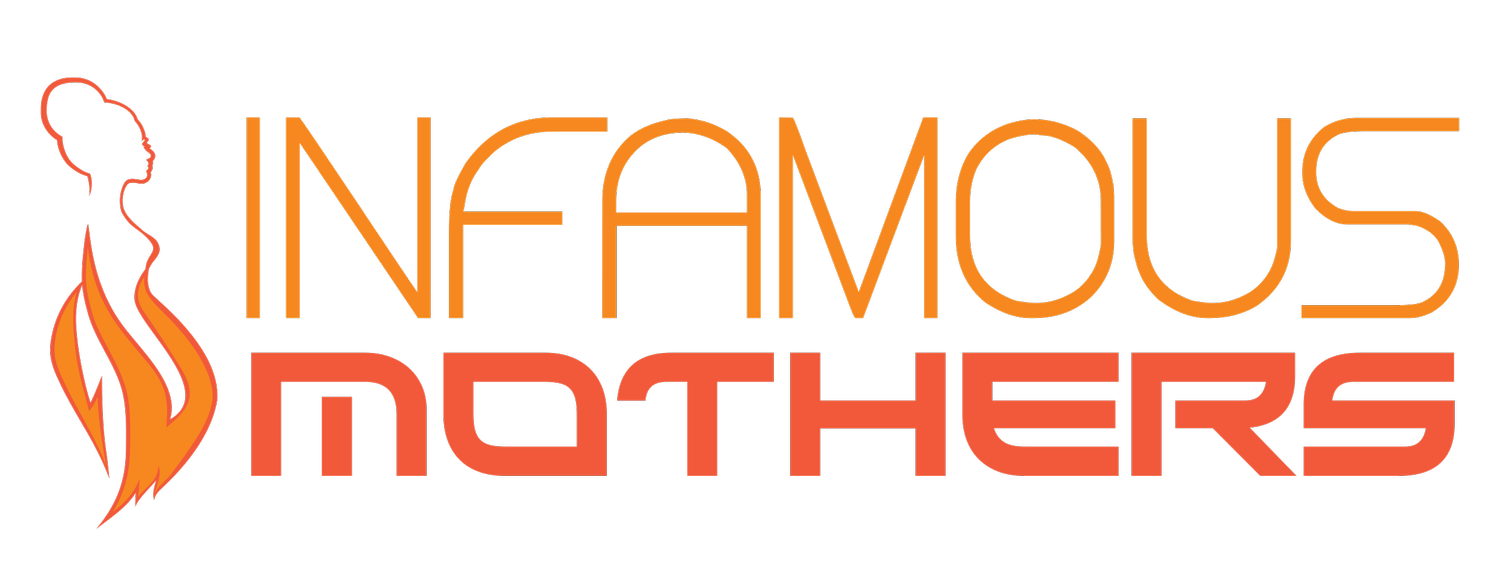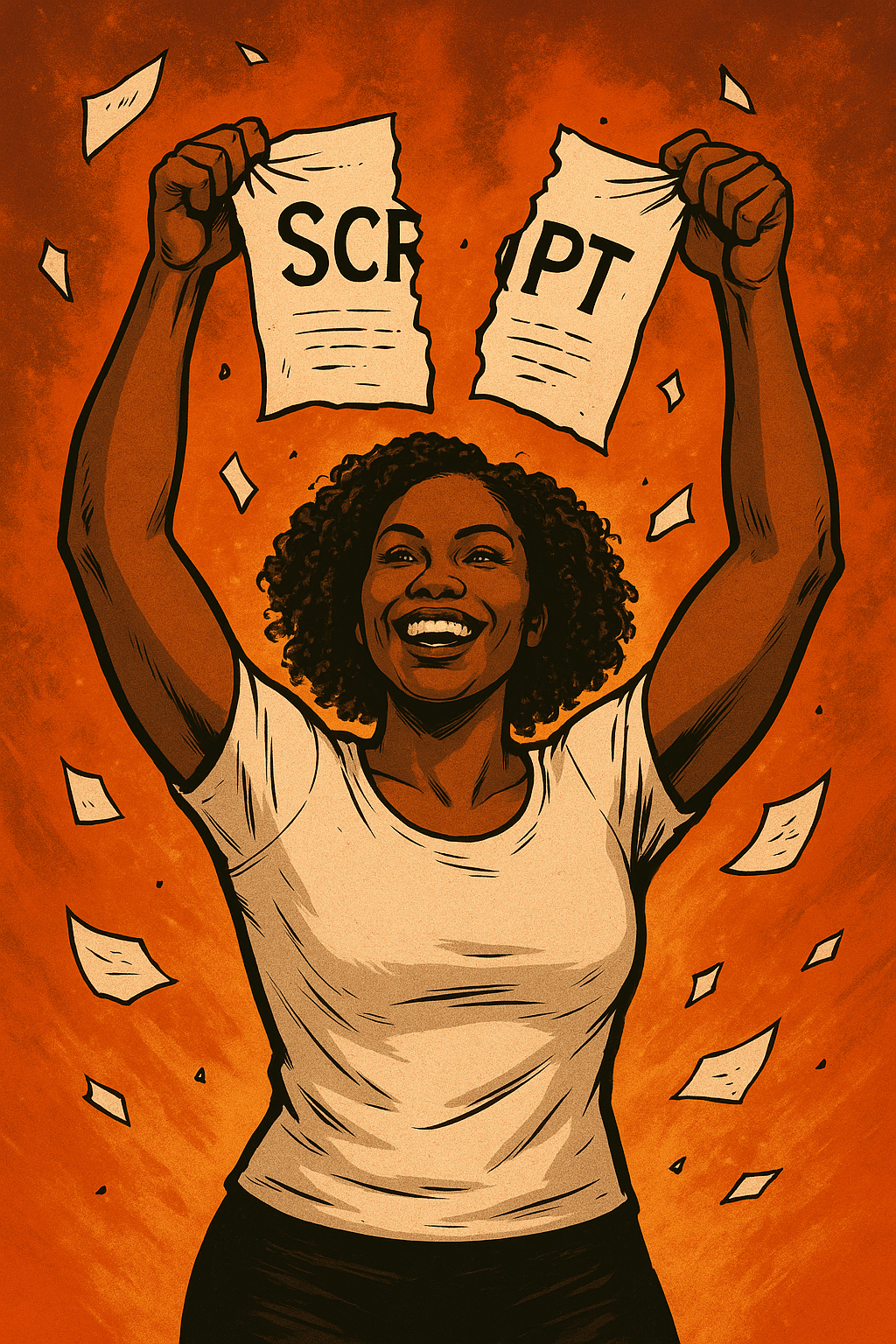Forged or Forged? Sis, Let’s Talk About the Fake Us
A woman in leggings, gym shoes, and a white t-shirt forging a glowing chain link on a fiery anvil, symbolizing breaking cycles and reclaiming strength.
A few therapy sessions ago, my therapist and I were talking about blame and responsibility. Somehow, the conversation drifted to something I hadn’t spoken about in years—being touched inappropriately as a child.
I remembered what one of the adults in my life told me afterward:
“If you had obeyed and not gone downstairs when you were told not to, that wouldn’t have happened to you.”
I was four.
Four.
Sis, I could barely tie my shoes, and somehow I was supposed to tie down an entire grown man’s choices? I’m side-eyeing everyone right now. But anyhoo, I digress.
That moment didn’t just sting. It carved something into me. Not just shame. Not just silence. But confusion—about who was supposed to protect me, and what I was supposed to be responsible for.
Even though my parents tried to build me up and instill confidence, the world was doing its own work on me, too. In some places, it got to me first—before love or safety ever could.
That day in therapy was the first time I saw it clearly: pieces of me had been forged without my consent—and not all in ways that made me stronger. Let’s be clear: not every scar is a badge. Some scars are meant to be indicators of straight-up theft. They are meant to signal to us that something ain’t right. ”Once I saw it, I started noticing other moments where my identity had been rewritten without my say-so.
That’s when the word forge found me. And I couldn’t let it go.
Two chain links side by side in a forge. One glows brightly, reforged in fire, symbolizing strength. The other is bent, cracked, and dull, symbolizing falsification and fragility.
Forged by Fire or Falsified? What It Really Means
I like words. Especially words with dual meanings—words that hold contradictions, words that make you pause, question, and choose.
Forge means two things:
🔥 To be forged by fire—refined, strengthened, purified.
🛑 To be forged as in falsified—altered, manipulated, stripped of truth.
Same word. Same spelling. Two completely different outcomes. One will crown you. The other will clown you. Tuh.
And the more I thought about it, the more it hit me: This isn’t just a wordplay issue. This is a life issue.
Because what happens when you think you’re being strengthened—but you’re actually being rewritten?
💭 Reflection Prompt: Think about the moments in your life that shaped you. Which ones made you stronger? Which ones reshaped you in ways that made you smaller?
Reader Reflection: If you’re honest, do you know which version of yourself is steering your life right now—the refined one or the falsified one? Or are you carrying both without realizing it?
Comic book style illustration of a triumphant Black woman tearing a contract labeled “Script” in half and raising the pieces above her head. Torn pages float around her like confetti, while a fiery orange glow radiates behind her, symbolizing liberation and rewriting her own story.
A Personal Story: How My Identity Was Rewritten
I was talking to a friend about my relationship with men, and he said something that stuck with me like gum on the bottom of my shoe:
“A lot of Black women don’t trust Black men. They don’t trust that they’ll take care of them, catch them if they fall, protect or provide for them.”
He wasn’t wrong. But what shook me was why it felt so deeply true for me—not just in my head, but in my body, like it was written into my blueprint.
I grew up in the crack era, surrounded by men struggling with addiction. Stability, protection, safety? Those weren’t things I learned to expect from them.
So I learned to depend on women. Women who carried everything. Women who shielded the men around them from the weight of the world while holding the world up themselves.
Without realizing it, I was handed a script about men—one that shaped how I saw them, how I loved them, and what I believed they were capable of:
Men were fragile.
Men were unreliable.
If you asked too much of them, you’d break them.
So I protected them. From police. From stress. From feeling like they’d failed. I was the peace. I was the one who held them down.
But I did not challenge them. Because the world was already breaking them—why would I be another thing that did?
Somewhere in there, the shift happened. I went from expecting care… to carrying everybody and their mama.
That wasn’t me. That was the damn script.
My thoughts, values, and beliefs had been rewritten—and I didn’t even know it. I had become a walking forgery of myself.
💭 Reflection Prompt: Who handed you the “script” you live by in relationships, work, or family? Did you choose it—or did it choose you?
Reader Reflection: Consider this—if you inherited this script without questioning it, what would happen if you rewrote it on your own terms?
A woman in a white button-up shirt, red pencil skirt, black wedge heels, messy bun, and glasses standing beside a towering podium on a stage. Behind her, a giant glowing silhouette radiates in fiery orange tones, symbolizing her authentic power despite appearing shrunken.
What This Blog Is Arguing
Many of us are carrying two versions of ourselves—one refined by experience, and one falsified by trauma, conditioning, and inherited scripts.
These “rewritten” parts often happen without our consent or awareness.
Liberation comes from recognizing where we’ve been forged in ways that serve us, and where we’ve been forged in ways that diminish us—and then intentionally burning away the false version.
In other words:
I’m urging you to examine the contradictions within yourself, identify the parts that aren’t truly yours, and commit to living from the most authentic version possible.
Signs You’re Living a Falsified Version of Yourself
Some parts of us have been refined—made stronger, bolder, sharper.
Other parts have been falsified—made smaller, more diluted, distorted.
✔ Resilient—but exhausted.
✔ Confident—but still seeking permission.
✔ Leading—but shrinking in certain spaces.
✔ Powerful—but in ways shaped for others’ benefit, not our own.
Sound familiar? That’s not strength, Sis. That’s survival in a stiff wig—not a good look, Boo.
It happens when we’re taught to:
🚨 Be strong—but only in ways that don’t make others uncomfortable.
🚨 Succeed—but not so much that others feel left behind.
🚨 Lead—but only in ways that are palatable.
So what happens?
💥 We become people who are both genuine and compromised.
💥 We become people who are both more powerful and weakened.
💥 We become people who are walking in a version of ourselves that is strong—but not fully free.
And the worst part? Most of us don’t even recognize the contradiction we’re carrying, let alone the consequences and implications that come with it.
💭 Reflection Prompt: Which of these contradictions feels most true for you right now? What would it take to remove the parts that aren’t yours?
Reader Reflection: Which “strengths” in your life are actually survival strategies that no longer serve you?
A woman stands inside a glowing barrier made of floating books, journals, candles, and plants, radiating fiery orange tones that symbolize empowerment and protection.
When Did the Shift Happen for You?
When something is forged — like a document — it’s usually without permission.
It’s an unauthorized change. A hidden manipulation. And the worst part? The person it happens to doesn’t even know it.
What if that happens to people? To women? To us?
What if so many of us are moving through life — teaching, preaching, mothering, leading, building — completely unaware that somewhere along the way a part of our identity was altered?
What if we’re operating as knock-off versions of ourselves — not completely fake, but not fully real either. Not a counterfeit, but not our highest, most powerful selves.
Because here’s the truth: many of us have been violated, disrespected, underestimated. Overworked and underpaid. Lied to, lied on, cheated on, judged, dismissed. And somewhere in that process, an unauthorized, illegal, and unrecognized change may have been made in us.
Somewhere along the way, someone or something — a system, a relationship, an experience — may have altered us without our consent. Something could have made us a lesser version of ourselves. And if we are a lower-quality version of who we were before we encountered that thing, shouldn’t we know about it?
Many of us don’t — because the change was ever so slight. It didn’t announce itself. It crept in quietly, a subtle shift here, a compromise there, until one day we’re showing up as someone almost—but not quite—ourselves. The change was small enough to go unnoticed, but powerful enough to dull our brilliance, mute our voice, and chip away at our audacity.
A statuesque woman with toffee-colored skin, long wavy hair, and a cardigan stands in glowing flames. She radiates confidence, beauty, and resilience.
We Are in Positions to Inspire Growth—or Stifle It
Some of us are leaders, mentors, parents, teachers, partners, bosses, coaches. We hold positions of influence, whether we realize it or not.
And that means we have the power to do one of two things:
✔ We can be a part of someone else’s refinement process. We can pour into people, challenge them, push them toward their highest selves. We can be the fire that helps to sharpen, strengthen, and clarify.
🛑 Or we can be part of a process that distorts them. Sometimes knowingly, sometimes unknowingly. We can project our fears onto them, pass down outdated beliefs, or limit them in ways we don’t even recognize.
And here’s where it gets tricky:
🚨 You can think you’re empowering someone when you’re actually stifling them.
🚨 You can think you’re challenging someone when you’re actually making them doubt themselves.
Think about the advice we were given growing up.
Some of us had people who told us to dream big—but only within reason.
Some of us were taught to be strong—but only in ways that didn’t make others uncomfortable.
Some of us were encouraged to succeed—but not too much, or we’d come across as arrogant.
So we internalized contradictions.
And now, without even realizing it, some of us are passing those contradictions down.
A woman sits at a desk with an open notebook and pen. Wearing a bold t-shirt that reads “Apologize for What?”, she rests her chin on her hand, her expression both thoughtful and subtly sassy. Glowing orange flames swirl around her, casting light on her face and posture.
The Question We Need to Ask Ourselves
So now, the real question isn’t “Have I been forged?”
The real question is:
In what way have I been forged? Have I been refined, or have I pieces of me been overwritten— without my knowledge or consent— in a way that doesn’t serve me, those connected to me, or my value system?
✔ Where have I gained strength?
✔ Where have I unknowingly lost power?
✔ Where have I been shaped into a more authentic version of myself?
✔ And where have I been unknowingly reshaped to fit a mold that wasn’t mine?
Because at someone point, there will be a reckoning where existing as both versions ourselves will become untenable.
At some point, one of these versions has to burn.
🔥 The one that was stamped onto you?
🔥 Or the one that was cultivated and shaped into something higher?
That’s the real work.
That’s the real question.
And that’s what we need to sit with.
A hand with red-painted nails releasing ash into the wind. Some particles fall as gray dust while others glow like fiery embers rising upward, against a background of deep orange and red tones symbolizing release and transformation.
Welcome to the Real Deal: Uncovering the Hidden Versions of Ourselves
In the last blog series, we talked about resilience—how we survive, how we push through, how we endure. But, sis, resilience alone isn’t enough when parts of us are secretly operating on a lower frequency. It’s one thing to live unapologetically, and it’s another to unknowingly be a knock-off version of ourselves.
This 12-week series is about getting into the crud and exposing the hidden ways we’re not fully showing up—why we might be operating as lesser versions of ourselves, how it’s happening, and what we can do about it.
Here’s how we’re breaking it down:
🔥 Weeks 1–4: Forge—Exploring how parts of us have been altered without our consent and whether those changes have refined us or reduced us.
🔥 Weeks 5–8: Counterfeit—Examining the ways we present as real but aren’t fully authentic.
🔥 Weeks 9–12: Fake—Identifying where we’re performing instead of living in our unfiltered, unapologetic truth.
Because here’s the thing: It’s one thing to live unapologetically, but it’s another to be lost in the sauce as a knock-off version of yourself—whether you realize it or not.
Nah, sis, we’re not out here with our slips showing like that. We got you. Stay tuned as we unpack these layers, reveal the why and the how, and offer tools to help you move at higher frequencies than you even knew were possible.
It’s time to reclaim your power and step into the truest, most authentic version of yourself.
Call to Action…
Listen. If this word spoke to you, don’t just leave it here. Carry it with you. Wanted is where we keep the good tea flowing — a reminder every week that you are desired, you are dangerous, and you belong. It’s where we keep you updated on current events across the IMverse, including the Without Apology Tour. And it’s where we introduce new stories, people, and dirty words.
👉🏾 Join Wanted today.
ABOUT THE BLOGGER
Dr. Sagashus Levingston is an author, entrepreneur and PhD holder. She has two fur babies, Maya and Gracie, six children (three boys and three girls), and they all (including her partner) live in Madison, WI. She loves all things business, is committed to reminding moms of their power, and is dedicated to playing her part in closing the wealth gap for people of color and women. She believes that mothering is a practice, like yoga, and she fights daily to manage her chocolate intake. The struggle is real, y’all…and sometimes it’s beautiful.
Follow her on Instagram: @infamous.mothers









